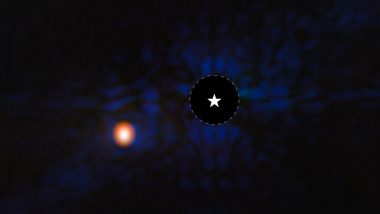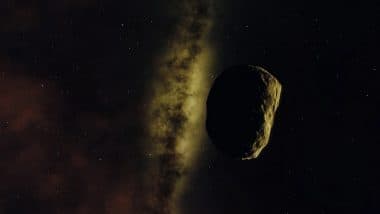New Delhi, July 25: A nearby "super-Jupiter" exoplanet -- about 12 light years away from Earth -- was detected and could be one of the coldest, according to an international study, including researchers from IIT Kanpur. Estimating the temperature on the planet at two degrees Celsius, the authors said that Epsilon Indi Ab is colder than any other imaged exoplanet -- planets existing outside of our solar system. The closest one is Proxima Centauri b at about four light years from Earth, according to NASA, the US space agency. Images of Epsilon Indi Ab were captured using NASA's James Webb Space Telescope.
Previously imaged exoplanets tend to be the youngest, hottest exoplanets that are still radiating much of the energy from when they first formed, according to the authors of the study published in the journal Nature. As planets cool and contract over their lifetime, they become significantly fainter and, therefore, harder to image, they said. The US space agency has confirmed the existence of about 5,000 of the billion exoplanets in our galaxy. Orbiting the star Epsilon Indi A, Epsilon Indi Ab has been dubbed a "super-Jupiter". Parade of Planets: Six Planets of Solar System, Excluding Earth, To Align in Straight Line Next Month; Check Date, Time and Visibility of Rare Planetary Alignment.
"It is a little warmer and more massive, but is more similar to Jupiter than any other planet that has been imaged so far," lead author Elisabeth Matthews of the Max Planck Institute for Astronomy, Germany, said. The "back-and-forth wobbles" of the star Epsilon Indi A that the researchers observed suggested hints of a possible planetary body. However, the planet did not match their modelled predictions, they said. "It's about twice as massive, a little farther from its star, and has a different orbit than we expected. The cause of this discrepancy remains an open question," Matthews said. Meteor Over Europe: Bright Blue Meteorite Captured Flying Through Sky Over Spain and Portugal (Watch Video).
The planet's atmosphere too was found to differ from the predictions. "The planet's atmosphere appears to have an unusual composition that indicates a high metal content and a different carbon-to-oxygen ratio than we see on our own solar system planets," study author Prashant Pathak, an assistant professor at the department of space, planetary and astronomical sciences and engineering (SPASE), IIT Kanpur, said. Using shorter wavelengths of light to detect the planet, the researchers found that the images were "fainter than expected."
NASA's James Webb Space Telescope Captures Images of Epsilon Indi Ab
Need to beat the heat?
Webb has snapped a direct image of Epsilon Indi Ab: the coldest and most Jupiter-like exoplanet to be imaged so far. To make the discovery, Webb blocked out starlight (shown by the star symbol) with a mask called a coronagraph: https://t.co/C8HE4Zsz13 pic.twitter.com/oL8rye3pzH
— NASA Webb Telescope (@NASAWebb) July 24, 2024
The researchers found that when using light of shorter wavelengths (violet has the shortest wavelength) to detect the planet, it was "fainter than expected." The team believes this may mean there is significant methane, carbon monoxide, and carbon dioxide in the planet's atmosphere that are absorbing the shorter wavelengths of light. It might also suggest a very cloudy atmosphere, they said. The findings open up "fascinating questions about (the planet's) formation and evolution," Pathak said. "By studying Eps Ind Ab and other nearby exoplanets, we hope to gain a deeper understanding of planetary formation, atmospheric composition, and the potential for life beyond our solar system," he added.
(This is an unedited and auto-generated story from Syndicated News feed, LatestLY Staff may not have modified or edited the content body)













 Quickly
Quickly






















